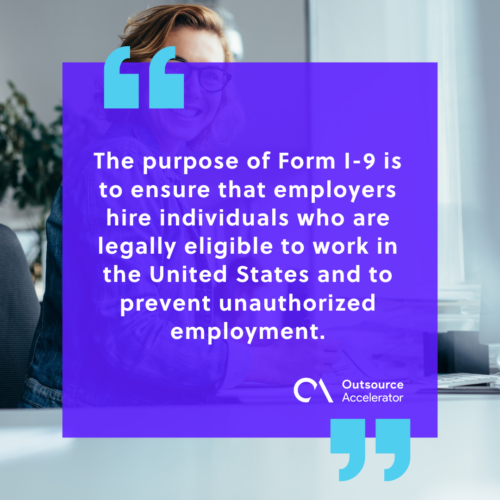Form I-9 filing process

If you’re new to the world of hiring and employment in the United States, you may have come across the term “Form I-9.”
But what is it, exactly? Why is it important? And how do you go about filling it?
In this article, we’ll explore the ins and outs of this document and guide you through the filing process.
What is Form I-9?
See Form I-9 (Rev. August 2023)
Form I-9, aka the Employment Eligibility Verification form, is a document mandated by the U.S. Citizenship and Immigration Services (USCIS).
The form is used to check who an individual is and if he or she is allowed to work in the United States.
The purpose of Form I-9 is to ensure that employers hire individuals who are legally eligible to work in the United States and to prevent unauthorized employment.
By completing this form, employers demonstrate their compliance with immigration laws and safeguard themselves against potential penalties.
Form I-9 also has a Spanish translation.

Who needs to complete Form I-9?
Both employers and employees have responsibilities concerning Form I-9.
All U.S. employers must complete and retain a form for each employee they hire, regardless of the employee’s citizenship or immigration status. This requirement applies to citizens, noncitizens, refugees, and individuals granted asylum.
It’s important to note that even if an employee is hired for only a short-term or temporary position, the form must still be completed within the specified timeframe.
Form I-9 essentially acts as a tool to ensure that the workforce is comprised of individuals who can legally work in the country.
Parts of Form I-9
Form I-9 has two sections: Section 1, which is completed by the employee, and Section 2, which is completed by the employer.
The filing process starts as soon as someone is hired.
Section 1
Employees must complete the first section on or before their first day of employment. This section collects basic personal information such as name, address, date of birth, and citizenship status.
Section 2
The employer is required to fill out Section 2 within a span of three business days from the employee’s initial workday.
This section requires the employer to examine and verify the employee’s identity and employment authorization documents, such as:
- Passport
- Driver’s license
- Social security card

Form I-9 retention period
Once filled out, Form I-9 is not a one-and-done deal. Employers are required to keep filled-out forms for a specific period.
For current employees, the form must be kept for as long as the individual works for the company.
For terminated employees, the retention period is either three years after the date of hire or one year after termination, whichever is later.
It’s crucial to adhere to the specified timelines for filing this verification document in order to maintain compliance with immigration regulations.
How to fill out Form I-9
Filling out the verification form may seem like a daunting task at first, but it doesn’t have to be. Let’s break it down step by step:
1. Employee completes Section 1
The employee fills out Section 1: Employee Information and Attestation.
Workers must provide accurate information about themselves, including their full name, address, date of birth, and citizenship status. They must also sign and date the form.
2. Employer completes Section 2
The employer reviews the employee’s identification documents to verify their identity and employment eligibility.
The employer must then record the document title, document number, and expiration date (if applicable) in Section 2: Employer Review and Verification.
Employers need to record the date of hire and sign and date the form.
3. Employer retains and stores Form I-9
Once both sections are completed, the employer must retain the form for the duration of the employee’s employment and a specific period afterward, as specified by the USCIS.
This can be either stored physically or electronically, as long as it is easily accessible for inspection if required by authorized government officials.
Form I-9 compliance for employment
Compliance with Form I-9 goes beyond merely filling out paperwork. Non-compliance can bring about hefty fines and legal repercussions.
Consider these key aspects:
- Document correctly. Minor errors or oversights in this process can lead to compliance issues down the road.
- Stay informed about changes. Immigration laws are subject to change, and Form I-9 is no exception. Employers must stay abreast of any updates to the form or its requirements to ensure ongoing compliance.
- Avoid discrimination. Employers must tread carefully to avoid discrimination when collecting and verifying employee information.
- Conduct internal audits. Regular internal audits can serve as a preemptive strike against compliance issues.
- Collaborate with legal experts. When in doubt, seek professional advice. Collaborating with legal experts specializing in immigration laws can provide clarity and guidance.

In the grand tapestry of employment regulations, Form I-9 stands out as a vital thread.
As an employer, embracing the responsibility of accurate documentation is not just a legal requirement — it’s a commitment to fostering an inclusive and compliant workplace.
It ensures that every individual contributing to the workforce is doing so within the bounds of the law, creating a foundation for a thriving and legally sound business environment.







 Independent
Independent




